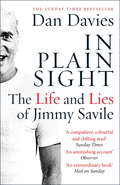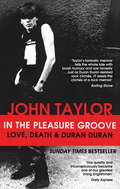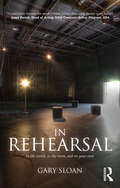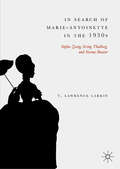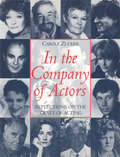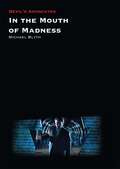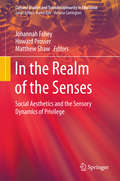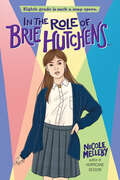- Table View
- List View
In Person: Reenactment in Postwar and Contemporary Cinema
by Ivone MarguliesIn Person: Reenactment in Postwar and Contemporary Cinema delineates a new performative genre based on replay and self-awareness. The book argues that in-person reenactment, an actual person reenacting her past on camera, departs radically from other modes of mimetic reconstruction. In Person theorizes this figure's protean temporality and revisionist capabilities and it considers its import in terms of social representativity and exemplarity. Close readings of select, historicized examples define an alternate, confessional-performative vein to understand the self-reflexive nature of postwar and post-holocaust testimonial cinemas. The book contextualizes Zavattini's proposal that in neorealism everyone should act his own story in a sort of anti-individualist, public display (Love in the City and We the Women). It checks the convergence between verit? experiments, a heightened self-critique in France and the reception of psychodrama in France (Chronicle of a summer and The Human Pyramid) in the late fifties. And, through Bazin, it reflects on the quandaries of celebrity biopics: how the circularity of the star's iconography is checked by her corporeal limits (Sophia her Own Story and the docudrama Torero!). In Person traces a shift from the exemplary and transformative ethos of fifties reenactment towards the un-redemptive stance of contemporary reenactment films such as Lanzmann's Shoah, Zhang Yuan's Sons, Andrea Tonacci's Hills of Chaos. It defines continuities between verite testimony (Chronicle, and Moi un Noir) and later para-juridical films such as the Karski Report and Rithy Panh's S21, the Khmer Rouge Killing Machine suggesting the power of co-presence and in person actualization for an ethics of viewership.
In Person: Reenactment in Postwar and Contemporary Cinema
by Ivone MarguliesIn Person: Reenactment in Postwar and Contemporary Cinema delineates a new performative genre based on replay and self-awareness. The book argues that in-person reenactment, an actual person reenacting her past on camera, departs radically from other modes of mimetic reconstruction. In Person theorizes this figure's protean temporality and revisionist capabilities and it considers its import in terms of social representativity and exemplarity. Close readings of select, historicized examples define an alternate, confessional-performative vein to understand the self-reflexive nature of postwar and post-holocaust testimonial cinemas. The book contextualizes Zavattini's proposal that in neorealism everyone should act his own story in a sort of anti-individualist, public display (Love in the City and We the Women). It checks the convergence between verit? experiments, a heightened self-critique in France and the reception of psychodrama in France (Chronicle of a summer and The Human Pyramid) in the late fifties. And, through Bazin, it reflects on the quandaries of celebrity biopics: how the circularity of the star's iconography is checked by her corporeal limits (Sophia her Own Story and the docudrama Torero!). In Person traces a shift from the exemplary and transformative ethos of fifties reenactment towards the un-redemptive stance of contemporary reenactment films such as Lanzmann's Shoah, Zhang Yuan's Sons, Andrea Tonacci's Hills of Chaos. It defines continuities between verite testimony (Chronicle, and Moi un Noir) and later para-juridical films such as the Karski Report and Rithy Panh's S21, the Khmer Rouge Killing Machine suggesting the power of co-presence and in person actualization for an ethics of viewership.
In Plain Sight: The Life and Lies of Jimmy Savile
by Dan DaviesWinner of the 2015 Gordon Burn Prize and the 2015 CWA Non-Fiction DaggerShortlisted for the Orwell Prize and the James Tait Black PrizeDan Davies has spent more than a decade on a quest to find the real Jimmy Savile, and interviewed him extensively over a period of seven years before his death. In the course of his quest, he spent days and nights at a time quizzing Savile at his homes in Leeds and Scarborough, lunched with him at venues ranging from humble transport cafes to the Athenaeum club in London and, most memorably, joined him for a short cruise aboard the QE2. Dan thought his quest had come to an end in October 2011 when Savile's golden coffin was lowered into a grave dug at a 45-degree angle in a Scarborough cemetery. He was wrong. In the last two and a half years, Dan has been interviewing scores of people, many of them unobtainable while Jimmy was alive. What he has discovered was that his instincts were right all along and behind the mask lay a hideous truth. Jimmy Savile was not only complex, damaged and controlling, but cynical, calculating and predatory. He revelled in his status as a Pied Piper of youth and used his power to abuse the vulnerable and underage, all the while covering his tracks by moving into the innermost circles of the establishment.
In The Pleasure Groove: Love, Death and Duran Duran
by John TaylorWith Duran Duran, John Taylor has created some of the greatest songs of our time. From the disco dazzle of debut single 'Planet Earth' right up to their latest number one album All You Need is Now, Duran Duran has always had the power to sweep the world onto its feet.It's been a ride - and for John in particular, the ride has been wild, thrilling... and dangerous. Now, for the first time, he tells his incredible story - a tale of dreams fulfilled, lessons learned and demons conquered. A shy only child, Nigel John Taylor wasn't an obvious candidate for pop stardom and frenzied girl panic. But when he ditched his first name and picked up a bass guitar, everything changed. John formed Duran Duran with his friend Nick Rhodes in the spring of 1978, and they were soon joined by Roger Taylor, then Andy Taylor and finally Simon Le Bon. Together they were an immediate, massive global success story, their pictures on millions of walls, every single a worldwide hit. In his frank, compelling autobiography, John recounts the highs - hanging out with icons like Bowie, Warhol and even James Bond; dating Vogue models and driving fast cars - all the while playing hard with the band he loved. But he faced tough battles ahead - troubles that brought him to the brink of self-destruction - before turning his life around.Told with humour, honesty and hard-won wisdom, and packed with exclusive pictures, In the Pleasure Groove is a fascinating, irresistible portrait of a man who danced into the fire... and came through the other side.
In Rehearsal: In the World, in the Room, and On Your Own
by Gary SloanIn Rehearsal is a clear and accessible how-to approach to the rehearsal process. Author Gary Sloan brings more than thirty years' worth of acting experience to bear on the question of how to rehearse both as an individual actor and as part of the team of professionals that underpins any successful production. Interviews with acclaimed actors, directors, playwrights, and designers share a wealth of knowledge on dynamic collaboration. The book is divided in to three main stages, helping the reader to refine their craft in as straightforward and accessible manner as possible: In the world: A flexible rehearsal program that can be employed daily, as well as over a typical four week production rehearsal. In the room: Advice on working independently and productively with other members of a company, such as directors, playwrights, designers and technical crew; how your personal creative process varies depending on the role, be it Shakespeare, musicals, film, television or understudying. On your own: Creating your own rehearsal process, exploring original and famous rehearsal techniques, breaking through actor's block and how to practice every day. In Rehearsal breaks down the rehearsal process from the actor’s perspective and equips its reader with the tools to become a generous and resourceful performer both inside and outside the studio. Its independent, creative and daily rehearsal techniques are essential for any modern actor.
In Rehearsal: In the World, in the Room, and On Your Own
by Gary SloanIn Rehearsal is a clear and accessible how-to approach to the rehearsal process. Author Gary Sloan brings more than thirty years' worth of acting experience to bear on the question of how to rehearse both as an individual actor and as part of the team of professionals that underpins any successful production. Interviews with acclaimed actors, directors, playwrights, and designers share a wealth of knowledge on dynamic collaboration. The book is divided in to three main stages, helping the reader to refine their craft in as straightforward and accessible manner as possible: In the world: A flexible rehearsal program that can be employed daily, as well as over a typical four week production rehearsal. In the room: Advice on working independently and productively with other members of a company, such as directors, playwrights, designers and technical crew; how your personal creative process varies depending on the role, be it Shakespeare, musicals, film, television or understudying. On your own: Creating your own rehearsal process, exploring original and famous rehearsal techniques, breaking through actor's block and how to practice every day. In Rehearsal breaks down the rehearsal process from the actor’s perspective and equips its reader with the tools to become a generous and resourceful performer both inside and outside the studio. Its independent, creative and daily rehearsal techniques are essential for any modern actor.
In Search of Legitimacy: How Outsiders Become Part of the Afro-Brazilian Capoeira Tradition (Dance and Performance Studies #7)
by Lauren Miller GriffithEvery year, countless young adults from affluent, Western nations travel to Brazil to train in capoeira, the dance/martial art form that is one of the most visible strands of the Afro-Brazilian cultural tradition. In Search of Legitimacy explores why “first world” men and women leave behind their jobs, families, and friends to pursue a strenuous training regimen in a historically disparaged and marginalized practice. Using the concept of apprenticeship pilgrimage—studying with a local master at a historical point of origin—the author examines how non-Brazilian capoeiristas learn their art and claim legitimacy while navigating the complexities of wealth disparity, racial discrimination, and cultural appropriation.
In Search of Marie-Antoinette in the 1930s: Stefan Zweig, Irving Thalberg, and Norma Shearer
by T. Lawrence LarkinIn Search of Marie-Antoinette in the 1930s follows Austrian biographer Stefan Zweig, American producer Irving Thalberg, and Canadian-American actress Norma Shearer as they attempt to uncover personal aspects of Marie-Antoinette’s life at the French court in the late eighteenth-century and to dramatize them in biography, cinema, and performance for public consumption during the 1930s. The first chapter establishes the core subject as an inquiry into the respective contributions of Zweig, Thalberg, and Shearer in formulating an “objective” or “authentic” image of “Marie-Antoinette.” The three chapters that follow examine in some detail how Zweig pursued research and drafted the psychological biography at his Salzburg home, Thalberg acquired film rights to the best-selling book and fought the censors to preserve the more sensational aspects of the screenplay at the Culver City studio, and Shearer worked closely with a new producer to give the script a strong romantic angle and to perform the character of the queen on the sound stage. The professionals’ research standards and strategic objectives are weighed in the formulation of a new myth at once sensitive to the historical record and suited to the leisure market.
In Search of Stanislavsky’s Creative State on the Stage: With a Practice as Research Case Study
by Gabriela CurpanThis book rediscovers a spiritual way of preparing the actor towards experiencing that ineffable artistic creativity defined by Konstantin Stanislavski as the creative state. Filtered through the lens of his unaddressed Christian Orthodox background, as well as his yogic or Hindu interest, the practical work followed the odyssey of the artist, from being oneself towards becoming the character, being structured in three major horizontal stages and developed on another three vertical, interconnected levels. Throughout the book, Gabriela Curpan aims to question both the cartesian approach to acting and the realist-psychological line, generally viewed as the only features of Stanislavski’s work. This book will be of great interest to theatre and performance academics as well as practitioners in the fields of acting and directing.
In Search of Stanislavsky’s Creative State on the Stage: With a Practice as Research Case Study
by Gabriela CurpanThis book rediscovers a spiritual way of preparing the actor towards experiencing that ineffable artistic creativity defined by Konstantin Stanislavski as the creative state. Filtered through the lens of his unaddressed Christian Orthodox background, as well as his yogic or Hindu interest, the practical work followed the odyssey of the artist, from being oneself towards becoming the character, being structured in three major horizontal stages and developed on another three vertical, interconnected levels. Throughout the book, Gabriela Curpan aims to question both the cartesian approach to acting and the realist-psychological line, generally viewed as the only features of Stanislavski’s work. This book will be of great interest to theatre and performance academics as well as practitioners in the fields of acting and directing.
In Secrecy's Shadow: The OSS and CIA in Hollywood Cinema 1941-1979 (Traditions in American Cinema)
by Simon WillmettsDuring the Second World War hundreds of Hollywood filmmakers under the command of the legendary director John Ford enlisted in the OSS to produce training, reconnaissance and propaganda films. This wartime bond continued into the post-war period, when a number of studios produced films advocating the creation of a permanent peacetime successor to the OSS: what became the Central Intelligence Agency. By the 1960s however, Hollywood's increasingly irreverent attitude towards the CIA reflected a growing public anxiety about excessive US government secrecy. In Secrecy's Shadow provides the first comprehensive history of the birth and development of Hollywood's relationship with American intelligence. It takes an interdisciplinary approach, synthesizing literatures and methodologies from diplomatic history, film studies and cultural theory, and it presents new perspectives on a number of major filmmakers including Darryl F. Zanuck, Alfred Hitchcock and John Ford. Based on research conducted in over 20 archival repositories across the United States and UK, In Secrecy's Shadow explores the revolution in the relationship between Hollywood and the secret state, from unwavering trust and cooperation to extreme scepticism and paranoia, and demonstrates the debilitating effects of secrecy upon public trust in government and the stability of national memory.
In Short: A Guide to Short Film-Making in the Digital Age
by Eileen Elsey Andrew KellyThis work looks at the history of the short film and its current role. It focuses on contemporary short-film producers and directors, and its role as a training opportunity for new talent. It also covers issues of distribution, funding, exhibition, festivals, training and publications.
In Short: A Guide to Short Film-Making in the Digital Age
by Eileen Elsey Andrew KellyThis work looks at the history of the short film and its current role. It focuses on contemporary short-film producers and directors, and its role as a training opportunity for new talent. It also covers issues of distribution, funding, exhibition, festivals, training and publications.
In Strictest Confidence
by Craig Revel HorwoodThe third instalment in Craig Revel Horwood’s frank and funny autobiography takes the reader through the highs and lows of the Strictly Come Dancing star’s ‘fab-u-lous’ life. Join Craig and a host of Strictly stars – including Ore Oduba, Judy Murray and the unforgettable Ed Balls – on the show and live tours and get the real stories from behind the scenes.The Aussie-born judge shares his famously forthright views on the changes in the show’s line up, from Bruce Forsyth and Len Goodman’s departures to the arrival of Claudia Winkleman and Shirley Ballas, as well as the dancers and stars.Away from Strictly, Craig reveals fresh heartache over failed romances, his pain at losing his dad and how his work kept him from flying to Australia for the funeral. He marks the milestones in his life, including turning fifty and moving from London to live in a ‘gorgeous’ country pile, as well as going under the knife for a second hip operation plus a few nips and tucks.The multi-talented dancer, director and choreographer also discusses his award-winning shows, including Sister Act and Son of a Preacher Man, and spending a year in drag as Miss Hannigan in Annie. Plus, he reveals all about his foray into movies, choreographing Hugh Grant for Paddington 2 and making his big screen debut in Nativity Rocks.With his famous wit and a wealth of backstage gossip, In Strictest Confidence is the perfect read for all his fans as well as those of Strictly Come Dancing.
In the Company of Actors: Reflections on the Craft of Acting
by Carole ZuckerIn the Company of Actors is a wonderful ensemble of entertaining and illuminating discussions with sixteen of the most celebrated and prestigious actors in contemporary theatre, film and television. The impressive list of actors includes: Eileen Atkins, Alan Bates, Simon Callow, Judi Dench, Brenda Fricker, Nigel Hawthorne, Jane Lapotaire, Janet McTeer, Ian Richardson, Miranda Richardson, Stephen Rea, Fiona Shaw, Anthony Sher, Janet Suzman, David Suchet, and Penelope Wilton. Carole Zucker covers a wide range of topics including the actors' main childhood influences, their actor training, early acting experience, preparation for roles and sound advice for coping with actors' problems such as creative differences with other actors or directors.
In the Company of Actors: Reflections on the Craft of Acting (Stage And Costume Ser.)
by Carole ZuckerIn the Company of Actors is a wonderful ensemble of entertaining and illuminating discussions with sixteen of the most celebrated and prestigious actors in contemporary theatre, film and television. The impressive list of actors includes: Eileen Atkins, Alan Bates, Simon Callow, Judi Dench, Brenda Fricker, Nigel Hawthorne, Jane Lapotaire, Janet McTeer, Ian Richardson, Miranda Richardson, Stephen Rea, Fiona Shaw, Anthony Sher, Janet Suzman, David Suchet, and Penelope Wilton. Carole Zucker covers a wide range of topics including the actors' main childhood influences, their actor training, early acting experience, preparation for roles and sound advice for coping with actors' problems such as creative differences with other actors or directors.
In the Footsteps of the Quiet Man: The Inside Story of the Cult Film
by Gerry McneeTurned down by all the major film companies, The Quiet Man brought together John Wayne and Maureen O'Hara for only the second time on screen, won two Oscars and was showered with both critical and popular praise on both sides of the Atlantic. Even today, its worldwide video and DVD sales are quite outstanding. The Quiet Man is rightly hailed as a Hollywood classic. Set in the 1920s and shot in the 1950s, the timeless, fairy-tale character of director John Ford's Ireland is as captivating now as it ever was. Gerry McNee first saw the movie when he was very young and it has intrigued him ever since. In the Footsteps of the Quiet Man is a tribute to the film and all those involved in its making, for the story behind the story, the off-screen drama, is a fascinating tale in itself. McNee has researched his subject thoroughly and conducted countless interviews to produce a stimulating and compulsive homage to what critic and author Andrew Sarris called 'a retreat into the pastoral and horse-driven past [but] very much ahead of its time'. In the Footsteps of the Quiet Man is a revealing and touching account of when Hollywood came to beautiful Connemara in the West of Ireland. It is a fitting tribute to the film and all those involved in its making, as the story behind the film - the off-screen drama - is an enthralling tale in itself.
In the Mood for Love (BFI Film Classics)
by Tony RaynsSet in Hong Kong, Singapore and Cambodia in the 1960s, Wong Kar Wai's In the Mood for Love (2000) is a film that luxuriates in the feeling of being in love – without ever turning into a love story. Its central characters, Mr Chow and Mrs Chan, are tenants in next-door apartments in Hong Kong who discover that their respective spouses are having an affair. Both of them have promiscuous colleagues at work, but they struggle to make sense of their partners' behaviour – and to control their growing feelings for each other. Hailed by the press as 'the consummate unconsummated love story of the new millennium', this film about desire repressed has become a firmly established classic of the twenty-first century. In his sharp and revealing analysis of In the Mood for Love, Tony Rayns draws on his considerable expertise in East Asian cinema and on his proximity to Wong Kar Wai and his colleagues at Jet Tone during the film's long and complicated genesis. He delivers a personal and highly original commentary on the film and its production, complete with privileged insights into Wong's idiosyncratic working methods and influences. The book also places the film in the context of Wong's other work, with sidelights on its place in Hong Kong cinema as a whole. This special edition features original cover artwork by Jimmy Turrell.
In the Mouth of Madness (Devil's Advocates)
by Michael BlythSomewhat overlooked upon its initial release in 1995, John Carpenter's In the Mouth of Madness has since developed a healthy cult reputation. But far more than simply a fan favorite, this closing installment of the acclaimed director's self-described "apocalypse trilogy" (following The Thing and Prince Of Darkness) stands today as one of his most thematically complex and stylistically audacious pieces of work.The story of an insurance investigator drawn into the supposedly fictional universe of a best-selling horror novelist, the film is an extension of many recurring themes found in Carpenter's filmography (the end of the world, the loss of free will, a distrust of mass industry and global corporations, the cataclysmic resurgence of ancient evil), as well as an affectionate homage to the works of H. P. Lovecraft (and horror literature more broadly) and a self-reflexive celebration of the horror genre that predates the Scream-inspired postmodernist boom of late-'90s genre cinema. While numerous books and countless academic essays have been written about Carpenter's work, surprisingly little has focused exclusively on In the Mouth of Madness, a film which feels more prescient, more essential, and more daringly complex than ever. This book seeks to redress this imbalance, at last positioning this overlooked masterpiece as essential Carpenter.
In the Mouth of Madness (Devil's Advocates)
by Michael BlythSomewhat overlooked upon its initial release in 1995, John Carpenter's In the Mouth of Madness has since developed a healthy cult reputation. But far more than simply a fan favorite, this closing installment of the acclaimed director's self-described "apocalypse trilogy" (following The Thing and Prince Of Darkness) stands today as one of his most thematically complex and stylistically audacious pieces of work.The story of an insurance investigator drawn into the supposedly fictional universe of a best-selling horror novelist, the film is an extension of many recurring themes found in Carpenter's filmography (the end of the world, the loss of free will, a distrust of mass industry and global corporations, the cataclysmic resurgence of ancient evil), as well as an affectionate homage to the works of H. P. Lovecraft (and horror literature more broadly) and a self-reflexive celebration of the horror genre that predates the Scream-inspired postmodernist boom of late-'90s genre cinema. While numerous books and countless academic essays have been written about Carpenter's work, surprisingly little has focused exclusively on In the Mouth of Madness, a film which feels more prescient, more essential, and more daringly complex than ever. This book seeks to redress this imbalance, at last positioning this overlooked masterpiece as essential Carpenter.
In the Realm of the Senses: Social Aesthetics and the Sensory Dynamics of Privilege (Cultural Studies and Transdisciplinarity in Education)
by Johannah Fahey Howard Prosser Matthew ShawThis book charts new territory both theoretically and methodologically. Drawing on MacDougall’s notion of social aesthetics, it explores the sensory dimensions of privilege through a global ethnography of elite schools. The various contributors to the volume draw on a range of theoretical perspectives from Lefebvre, Benjamin, Bourdieu, Appadurai, Kress and van Leeuwen to both broaden and critique MacDougall’s original concept. They argue that within these elite schools there is a relationship between their ‘complex sensory and aesthetic environments’ and the construction of privilege within and beyond the school gates. Understanding the importance of the visual to ethnography, the social aesthetics of these elite schools are captured through the inclusion of a series of visual essays that complement the written accounts of the aesthetics of privilege. The collection also includes a series of vignettes that further explore the sensory dimension of these aesthetics: touch, taste—though metaphorically understood— sight and sound. These varying formats illustrate the aesthetic nature of social relations and the various ways in which class permeates the senses. The images from across the different schools and their surroundings immerse the reader in these worlds and provide poignant ethnographic data of the forces of globalisation within the context of elite schooling.
In the Realm of the Senses (BFI Film Classics)
by Joan MellenIn this work, Joan Mellen analyses 'In the Realm of the Senses', the controversial film which caused a sensation at the 1976 Cannes Film Festival.
In the Realm of the Senses (BFI Film Classics #Vol. 74)
by Joan MellenIn this work, Joan Mellen analyses 'In the Realm of the Senses', the controversial film which caused a sensation at the 1976 Cannes Film Festival.
In the Role of Brie Hutchens...
by Nicole MellebyWhen strong-willed, theatrical eighth grader Brie Hutchens tells a lie because she isn&’t quite ready to come out to her mother, she must navigate the consequences in her relationships with her family, friends, and faith in this own-voices LGBTQ novel from the acclaimed author of Hurricane Season.
In the Shadow of The Birth of a Nation: Racism, Reception and Resistance
by Melvyn Stokes Paul McEwanThis collection brings together many of the world’s leading scholars on race and film to re-consider the legacy and impact of D.W. Griffith’s deeply racist 1915 epic The Birth of a Nation. While this film is often cited, there is a considerable dearth of substantial research on its initial impact and global reach. These essays fill important gaps in the history of the film, including essential work on its sources, international reception, and African American responses. This book is a key text in the history of the most infamous and controversial film ever made and offers crucial new insights to scholars and students working in film history, African American history and the history of race relations.

